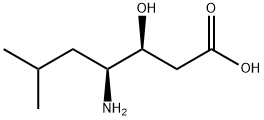
Статин
- английское имяSTATINE
- CAS №49642-07-1
- CBNumberCB9272763
- ФормулаC8H17NO3
- мольный вес175.23
- номер MDLMFCD00037277
- файл Mol49642-07-1.mol
| Температура плавления | 209 °C |
| альфа | D15 -20° (c = 0.64 in water) |
| Температура кипения | 306.53°C (rough estimate) |
| плотность | 1.1233 (rough estimate) |
| показатель преломления | 1.4476 (estimate) |
| температура хранения | 2-8°C |
| растворимость | 0.5 M HCl: 50 mg/mL, clear, very faintly yellow |
| пка | 3.97±0.10(Predicted) |
| форма | Solid |
| цвет | White to off-white |
| Мерк | 13,8879 |
| Словарь онкологических терминов NCI | statin |
| FDA UNII | YTC77XR1EK |
рисовальное письмо(GHS)
-
рисовальное письмо(GHS)

-
сигнальный язык
предупреждение
-
вредная бумага
H315:При попадании на кожу вызывает раздражение.
H319:При попадании в глаза вызывает выраженное раздражение.
H335:Может вызывать раздражение верхних дыхательных путей.
-
оператор предупредительных мер
P264:После работы тщательно вымыть кожу.
P280:Использовать перчатки/ средства защиты глаз/ лица.
P302+P352:ПРИ ПОПАДАНИИ НА КОЖУ: Промыть большим количеством воды.
P305+P351+P338:ПРИ ПОПАДАНИИ В ГЛАЗА: Осторожно промыть глаза водой в течение нескольких минут. Снять контактные линзы, если Вы ими пользуетесь и если это легко сделать. Продолжить промывание глаз.
P332+P313:При возникновении раздражения кожи: обратиться за медицинской помощью.
Статин химические свойства, назначение, производство
Химические свойства
white powderКлиническое использование
With the possible exception of atorvastatin, the statins are used to lower LDL cholesterol in familial or polygenic ( multifactorial) hypercholesterolemia (type IIa) and in combination with triglyceride-lowering drugs to treat combined hyperlipidemia (type IIb) when both LDL and VLDL (very low density lipoproteins) are elevated. However, the statins probably should not be given with the fibrates (triglyceridelowering drugs, discussed later), since this combination may greatly increase statin toxicity. Atorvastatin, the most potent of the available statins, has also been shown to lower blood triglycerides significantly.This effect may be due to decreasing hepatic cholesterol and cholesterol ester levels to such an extent that hepatic formation of VLDL is impaired.The statins also have been claimed to reduce blood cholesterol levels modestly in some patients with homozygous familial hypercholesterolemia, a condition often fatal in childhood or in early adulthood.
The statins may lower the risk of CHD by decreasing inflammation, an important component of atherogenesis. Lovastatin decreased elevated plasma levels of Creactive protein, a marker for cellular inflammation, and acute coronary events in patients with relatively low plasma cholesterol levels. Recent studies also suggest that use of statins may decrease the risk of stroke, dementia, and Alzheimer’s disease and may improve bone density in postmenopausal women. These broad actions may be related to the hypocholesterolemic, antiproliferative, antiinflammatory, or antioxidant properties of the statins or some combination of these properties.
Побочные эффекты
The statins generally appear to be well tolerated, with muscle pain and liver dysfunction seen in 1 to 2% of patients. However, the consequences of 20 to 30 years of continuous use are unknown. This fact has been dramatically reinforced by the recent recognition of a potentially fatal consequence of statin use. A relatively common side effect of the statins (perhaps 1% of patients) is myositis, that is, inflammation of skeletal muscle accompanied by pain, weakness, and high levels of serum creatine kinase. Rhabdomyolysis, i.e., disintegration of muscle with urinary excretion of myoglobin and kidney damage, was considered to be a rare and extreme toxic outcome. However, cerivastatin (Baycol) has now been withdrawn from the market by its manufacturer (Bayer) because of 31 deaths linked to fatal rhabdomyolysis. The risk of muscle damage is said to increase with simultaneous use of the triglyceride-lowering fibrates. Pravastatin may be less toxic than other statins because it does not readily penetrate extrahepatic cells and may be more confined to the liver after oral dosage.Статин запасные части и сырье
Статин поставщик
| поставщик | телефон | страна | номенклатура продукции | благоприятные условия |
|---|---|---|---|---|
| +1-781-999-5354 +1-00000000000 |
United States | 32161 | 58 | |
| +86-0371-86658258 +8613203830695 |
China | 30233 | 58 | |
| 16314854226; +16314854226 |
United States | 19741 | 58 | |
| +86-0571-81612335 +8613336028439 |
China | 19908 | 58 | |
| United States | 38631 | 58 | ||
| +86-852-30606658 | China | 43340 | 58 | |
| +8613564774135 | United States | 19881 | 58 | |
| 010-82967028 13552068683 |
China | 12443 | 60 | |
| 021-54306202 13764082696 |
China | 42958 | 64 | |
| 021-50135380 | China | 15402 | 60 |